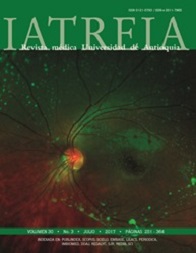Clinical and epidemiological round: Interrupted time series
DOI:
https://doi.org/10.17533/udea.iatreia.v30n3a11Keywords:
quasi-experimental, level, trend, interrupted time seriesAbstract
In quasi-experimental research, it is commonly used the interrupted time series analysis, which measures the effect of an intervention from a specific time point. This technique integrates longitudinal data and allows to discover detailed trends before and after such intervention. It is considered an important tool to understand the patterns of change after any event, it is applicable in different disciplines and have a great potential to draw conclusions in research with long follow-up periods that require objective evaluation of interventions.
Downloads
References
(1.) Kontopantelis E, Doran T, Springate DA, Buchan I, Reeves D. Regression based quasi-experimental approach when randomisation is not an option: interrupted time series analysis. BMJ. 2015 Jun;350:h2750. DOI 10.1136/bmj.h2750.
(2.) Shadish WR, Cook TD, Campbell DT. A critical assessment of our assumptions. In: Experimental and quasi-experimental designs for generalized causal inference. Boston: Houghton Mifflin; 2002. p. 456-97.
(3.) Wagner AK, Soumerai SB, Zhang F, Ross-Degnan D. Segmented regression analysis of interrupted time series studies in medication use research. J Clin Pharm Ther. 2002 Aug;27(4):299-309.
(4.) Fan E, Laupacis A, Pronovost PJ, Guyatt GH, Needham DM. How to use an article about quality improvement. JAMA. 2010 Nov;304(20):2279-87. DOI 10.1001/jama.2010.1692.
(5.) Penfold RB, Zhang F. Use of interrupted time series analysis in evaluating health care quality improvements. Acad Pediatr. 2013 Nov-Dec;13(6 Suppl):S38-44. DOI 10.1016/j.acap.2013.08.002.
(6.) Glass GV, Willson V, Gottman JM. Time-series experiments and the investigation of causal claims. In: Design and analysis of time-serie experiments. Boulder: Colorado Associated University Press; 2008. p. 1-18.
(7.) Box GEP, Tiao GC. Intervention Analysis with Applications to Economic and Environmental Problems. J Am Stat Assoc. 1975;70(349):70-9.
(8.) Escudero JR, Vallejo G. Comparación de tres métodos alternativos para el análisis de series temporales interrumpidas. Psicothema. 2000;12(3):480-6.
(9.) Meliá J. Un proceso de intervención para reducir los accidentes laborales. Rev Psicol Trab Organ. 1995;11(32):51-65.
(10.) Box GEP, Jenkins GM, Reinsel GC. Autocorrelation Function and Spectrum of Stationary Processes and Analysis of Seasonal Time Series. In: Time Series Analysis: Forecasting and Control. 2nd ed. San Francisco: Holden-Day; 1976. P.21-43.
(11.) Cabré R. Diseños de series temporales interrumpidas: técnicas alternativas de análisis [tesis doctoral]. Barcelona: Publicaciones Universitat; 1994.
(12.) León-Álvarez AL, Betancur-Gómez JI, Jaimes-Barragán F, Grisales-Romero H. z clínica y epidemiológica. Series de tiempo. Iatreia. 2016 Jul-Sep;29(3):373-381. DOI 10.17533/udea.iatreia.v29n3a12.
(13.) Vallejo G, Herrero J, Cuesta M. Comparación de la potencia y eficacia de diversos modelos ARIMA en series temporales interrumpidas: Un estudio de simulación. Rev Investig Psicol. 1992;10:174-214.
(14.) Gottman J, Glass G. Analysis of interrupted time-series experiments. In: Kratochwill J, editor. Single subject research: strategies for evaluation change. New York: Academic Press; 1978. p.197-235.
(15.) Dolgin NH, Movahedi B, Martins PN, Goldberg R, Lapane KL, Anderson FA, et al. Decade-Long Trends in Liver Transplant Waitlist Removal Due to Illness Severity: The Impact of Centers for Medicare and Medicaid Services Policy. J Am Coll Surg. 2016 Jun;222(6):1054-65. DOI 10.1016/j.jamcollsurg.2016.03.021.
(16.) Minard LV, Corkum A, Sketris I, Fisher J, Zhang Y, Saleh A. Trends in Statin Use in Seniors 1999 to 2013: Time Series Analysis. PLoS One. 2016 Jul;11(7):e0158608. DOI 10.1371/journal.pone.0158608.
(17.) Brubacher JR, Desapriya E, Erdelyi S, Chan H. The impact of child safety restraint legislation on child injuries in police-reported motor vehicle collisions in British Columbia: An interrupted time series analysis. Paediatr Child Health. 2016 May;21(4):e27-31.
Downloads
Published
How to Cite
Issue
Section
License
Copyright (c) 2017 Iatreia

This work is licensed under a Creative Commons Attribution-ShareAlike 4.0 International License.
Papers published in the journal are available for use under the Creative Commons license, specifically Attribution-NonCommercial-ShareAlike 4.0 International.
The papers must be unpublished and sent exclusively to the Journal Iatreia; the author uploading the contribution is required to submit two fully completed formats: article submission and authorship responsibility.














